20xx年中国保护知识产权行动计划
为深入实施国家知识产权战略,全面加强20xx年知识产权保护工作,按照国家知识产权战略实施工作部际联席会议安排,联席会议28家成员单位共同制定了《20xx年中国保护知识产权行动计划》(以下简称《行动计划》)。日前,该计划正式印发实施。
《行动计划》按照“完善制度、加强执法、突出专项、推进协调、强化宣传、规范管理”的指导方针,结合实际和各相关部门职能,从制定及修订知识产权法律法规和规范性文件、提高知识产权执法水平、发展知识产权服务、加强知识产权教育培训和人才队伍建设、推进知识产权宣传和文化建设以及扩大知识产权对外交流合作等6个方面提出100项具体措施,并明确了牵头和参与部门。整个计划层次分明,内容充实,重点突出,针对性强,对我国20xx年知识产权保护工作的全面开展具有重大指导作用。
国家知识产权战略实施工作部际联席会议办公室
为落实《国家知识产权战略纲要》总体部署,有效推动20xx年知识产权保护工作的全面开展,按照“完善制度、加强执法、突出专项、推进协调、强化宣传、规范管理”的指导方针,特制定本行动计划。
(一)制定、修订知识产权法律法规和规范性文件
1.专利、商标、版权法律法规和规章
(1)做好修改《专利代理条例》工作。
(2)修改《专利实施强制许可办法》。
(3)研究制定《职务技术成果条例》和《职务发明人流动中利益共享办法》。
(4)做好《商标法》修改工作,加快立法进程,启动《商标法实施条例》修改的调研工作。
(5)积极推进《著作权法》及其配套法规的修改工作。
(6)加快《民间文学艺术作品著作权保护办法》立法进度。
(7)制定《教科书法定许可付酬办法》,推动《作品自愿登记试行办法》修订。
2.其他法律法规和规章
(8)继续推进《生物遗传资源管理条例》的立法协调工作。
(9)开展《植物新品种保护条例》修订工作,研究《植物新品种保护法》的立法可行性。
(10)推进《对外贸易法》中“与对外贸易有关的知识产权保护”相关配套规章制定工作,协调起草《知识产权滥用反垄断指南》。
(11)加快《中医药法》的立法进程,继续做好《中医药法》立法的沟通协调工作,加强中医药传统知识保护。
(12)完成对《知识产权海关保护条例》实施办法的修订工作。
(13)完善《涉及专利的国家标准制修订管理规定(暂行)》。
(14)研究制定并发布林业植物新品种权审批规则。
(15)做好《反不正当竞争法》修改工作,在《反不正当竞争法》修订完成后,着手配套实施细则的起草、调研工作。
(16)组织开展《国防专利条例》修订工作,制定国防知识产权相关规章。
3.司法解释和规范性文件
(17)发布《最高人民法院关于在部分地方人民法院试行由知识产权庭集中审理知识产权民事、行政和刑事案件的若干意见》。
(18)出台《最高人民法院关于审理垄断民事纠纷案件适用法律若干问题的规定》。
(19)制定《关于办理侵犯知识产权刑事案件适用法律若干问题的意见》。
(20)完成网络环境下的著作权司法保护调研,起草关于审理网络著作权案件的司法解释。
(21)适时起草关于专利、商标授权确权行政案件审判标准和商业秘密司法保护的指导性意见。
(22)发布《关于加强知识产权司法保护 积极促进经济发展方式加快转变若干问题的意见》。
(23)继续修改并适时下发实行《企业职工档案管理规定》及《贯彻执行劳动合同法若干意见》等劳动法律配套规章,完善有关竞业限制等商业秘密保护政策。
(24)配合《非物质文化遗产法》的施行,研究制定《非物质文化遗产生产性保护扶持政策》、《非物质文化遗产传承人及传承机制建设政策》、《国家级非物质文化遗产名录项目分类保护规范》、《国家级文化生态保护区总体规划编制规范》、《非物质文化遗产珍贵实物管理办法》、《人口较少民族非物质文化遗产保护政策》等政策或指导性文件。
(25)出台《版权行政执法指导意见》,进一步完善版权行政执法体制,支持文化市场行政执法机构开展版权执法工作。
(二)提高知识产权执法水平
1.开展专项行动
(26)全面贯彻落实《打击侵犯知识产权和制售假冒伪劣商品专项行动方案》,组织协调专项行动开展,推动我国保护知识产权长效机制建设。
(27)大力推进政府机关和企业使用正版软件工作。采取有效措施,确保中央和地方政府机关20xx年按期完成正版化检查整改工作,配合财政和国家机关事务管理部门做好经费保障和软件资产管理,构建使用正版软件、抵制盗版软件的长效工作机制;加大推进企业使用正版软件工作力度,充分发挥行业协会在企业软
件正版化工作中的积极作用,加快推进外资、民营企业软件正版化工作,做好30家企业软件资产管理试点工作。
(28)开展打击网络侵权盗版行为的专项行动,加强对互联网站的主动监管,加大对网络侵权案件打击力度,重点打击利用互联网销售假冒伪劣商品、提供盗版影视作品、软件下载服务以及运营网络游戏私服、外挂等侵权犯罪活动,加强网络知识产权保护,建立网络版权行政保护的常态化机制。
(29)继续推进打击侵犯知识产权和制售伪劣商品犯罪的“亮剑”专项行动,强化指导协调和督促检查,确保全国专项行动整体推进。
(30)按照《关于做好全国打击侵犯知识产权和制售假冒伪劣商品专项行动律师工作的通知》的要求,组织引导律师做好侵犯知识产权和制售假冒伪劣商品犯罪案件的辩护代理工作。
(31)组织全国农业行政部门实施《打击侵犯品种权和制售假冒伪劣种子专项行动方案》,曝光一批侵权假冒企业,灭活处理一批假冒伪劣授权品种种子。
(32)组织开展文化市场专项整治行动,继续深入开展整治互联网、打击侵犯知识产权和制售假冒伪劣商品等专项行动。
(33)结合打击侵犯知识产权和制售假冒伪劣商品专项行动,深入开展中央企业知识产权自查自纠活动,并指导中央企业制定相应知识产权应急预案。
(34)根据打击侵犯知识产权和制售假冒伪劣商品专项行动要求,在全国海关范围内积极推进和部署,继续保持打击进出口侵权违法行为的高压态势,通过多种途径和方式加强对侵权信息的分析和处理,不断完善与知识产权权利人的配合机制,对进出口侵权商品的违法行为实施精准打击。
(35)提高打击侵犯知识产权和制售假冒伪劣商品专项行动实效,重点查处侵犯涉外商标和驰名商标的违法行为,切实扼制恶意商标抢注行为,严厉查处违法印制商标标识及仿冒知名商品包装装潢的行为。
(36)推进和落实打击生产领域侵犯知识产权和制售假冒伪劣产品专项行动各项工作,集中整治一批重点地区,并积极探索建立打击假冒保护知识产权的长效工
作机制,大力推进“12365”举报处置指挥系统建设,继续深入推进“打击假冒,保护名优”工作。
(37)组织“打击侵犯知识产权和制售假冒伪劣商品专项行动”重点地区查缴盗版出版物集中销毁活动,对重点案件进行挂牌督办,限时办结。
(38)组织开展打击制售假劣林木种苗和保护植物新品种权专项行动,严厉打击制售假劣林木种苗、依法查处无证无签生产经营林木种苗、新品种侵权和假冒等违法行为,依法保护育种者权益。
(39)组织落实《知识产权系统执法专项行动方案》,坚决打击反复、群体、恶意侵权及假冒专利行为,加大接受知识产权举报投诉力度,推进知识产权维权援助中心建设,强化展会知识产权保护,加强部门间区域间执法协作,推动行政执法与司法保护协调配合,切实做好执法检查与督导工作。
(40)依法积极配合打击侵犯知识产权和制售假冒伪劣商品专项行动,加大知识产权刑事司法保护力度,依法严厉制裁侵犯知识产权犯罪行为,充分发挥惩罚和震慑犯罪功能。
(41)积极参与打击侵犯知识产权和制售伪劣商品专项行动,依法严厉打击侵犯知识产权的犯罪,及时予以批捕和起诉,对重大、有影响的案件加强督办。
2.加强日常执法
(42)组织编写办理侵犯知识产权犯罪案件指导手册,帮助一线执法人员正确理解和适用相关法律,规范受案、办案工作。
(43)加强DNA等执法鉴定技术研究,制定主要作物的DNA指纹图谱鉴定规程,支持建立有资质的品种鉴定机构,完善品种权执法鉴定体系。
(44)积极开展计算机预装盗版软件的市场治理,集中加强对计算机生产企业的源头治理,加大对软件等重点产品的市场监管力度。
(45)推动建立版权争议调解机制,基本形成司法和行政有机衔接的版权争议民事调解机制。
(46)组织制定发布《20xx年中国保护知识产权行动计划》。
(47)推进知识产权维权援助中心建设,深入开展“5·26”执法推进工程和全国专利保护重点联系基地工作。
(48)组织全国法院开展“加强知识产权司法保护 促进经济发展方式转变”年度主题活动,召开“全国法院知识产权司法公开座谈会”。
(49)做好地理标志保护工作,加大监督抽检力度,严厉打击地理标志侵权假冒行为。
3.加强知识产权司法工作
(50)继续积极推动知识产权审判庭统一受理知识产权民事、行政和刑事案件试点工作。
(51)有效完善知识产权民事案件管辖制度,进一步扩大管辖一般知识产权案件的基层法院的范围,完善已指定法院的地域管辖范围。
(52)实施加强知识产权审判基层基础建设“三五工程”,选择具有知识产权案件管辖权的五个基层法院作为首批中国知识产权司法保护基层示范法院,选择五个中院作为首批最高人民法院知识产权司法保护研究基地,在全国范围内选择五所重点高校作为首批中国人民法院知识产权司法保护研究基地。
(53)开展“对行政执法机关移送涉嫌犯罪案件专项监督活动”,依法严肃查办行政执法部门有案不移、有案不立、有罪不究、以罚代刑、徇私舞弊等行为,及时予以监督纠正。
(54)进一步推动“两法衔接”工作,积极推动行政执法与刑事司法机关建立“网上衔接,信息共享”机制。
(三)发展知识产权服务
(55)组织制定知识产权司法鉴定分类规范、准入条件、执业规则等知识产权登记管理相关文件。
(56)就律师从事专利、商标代理业务的相关问题加强沟通协调,为律师从事专利代理业务创造条件,推动律师从事商标代理业务的规范性文件出台。
(57)研究制定《律师从事专利业务指引》、《律师从事商标业务指引》等指导性业务操作指南,帮助全国律师开展专利、商标等知识产权业务。
(58)吸纳更多的知识产权中介组织为实施农业知识产权战略纲要服务,支持农业企事业单位和社会组织以农业知识产权为纽带开展相关服务活动,指导种业知识产权联盟开展种业知识产权信息共享和维权救助工作。
(59)继续做好植物新品种保护技术支撑体系建设规划的落实工作,完善植物新品种测试机构功能和区域布局,努力建设世界一流的植物新品种测试体系。
(60)继续通过多种方式发布企业知识产权海外预警和指导信息,通过编写知识产权海外维权年度报告、发布行业专利技术分析报告、对企业进行知识产权保护培训、继续在境外知名展会上设立“中国参展企业知识产权服务站”等多种方式健全知识产权海外维权机制,指导和协助我国企业处理对外经贸关系中的重点涉外知识产权纠纷,推动企业知识产权海外维权中心试点。
(61)定期开展中美337调查交流,积极组织对337调查的立法修订进行评议,表达我国内产业、企业关注,加强对重大案件企业的应诉指导,同时对在337调查中取得胜诉的企业,努力协调各部门给予政策支持和帮助。
(62)推进非物质文化遗产保护信息化建设,制定非物质文化遗产数字化保护工程建设方案,制定全国统一的非物质文化遗产数字化标准体系,统筹规划非物质文化遗产数据库建设,初步建立起提供公众服务的数据库群。
(63)充分发挥集体管理组织、行业协会和版权中介机构的作用,进一步规范其市场行为,支持其依法开展业务活动,为其发展创造条件。
(64)创新版权公共服务形式,增强版权公共服务能力,提高作品登记和著作权合同登记备案的质量和数量。
(65)重点建设和完善林业植物新品种、与林业有关的专利、地理标志等内容的林业知识产权基础数据库,进一步完善林业知识产权公共信息平台和重点出口林产品知识产权预警机制,启动“中国林业知识产权网”,支持组建多种形式的保护联盟,为林业植物新品种的创造、保护与运用提供服务。
(66)稳步落实《海峡两岸知识产权保护合作协议》,进一步加强两岸在专利、商标、版权、植物新品种等领域的合作。
(四)加强知识产权教育培训和人才队伍建设
(67)鼓励地方和学校利用《义务教育课程设置方案》规定的可自主支配的课时,组织开展有关知识产权保护的教育活动,指导思想品德课教材编写组根据课程标准关于知识产权内容的教育要求,修订教材。
(68)继续推进在职攻读法律硕士专业学位教育知识产权方向班研究生培养工作。
(69)加大知识产权司法鉴定人岗前培训和继续教育力度,开展职业道德和执业纪律教育,进一步提高队伍整体素质。
(70)进一步加强公务员知识产权培训,加大指导和监督力度,继续将知识产权培训纳入各类培训,提高公务员知识产权保护意识。
(71)加强国家级非物质文化遗产项目代表性传承人保护,启动代表性传承人抢救性记录工程,落实补助经费,制定管理细则、出台扶持政策,研究制定对学艺者、继承者的助学、奖学等激励措施。
(72)加强版权培训工作,开展领导干部、执法人员、著作权人、版权相关企业经营者版权培训,培养版权专业人才。
(73)按照《国家中长期人才发展规划纲要(2010—20xx年)》任务分工方案要求,做好落实“实施知识产权保护政策”的组织工作,出台具体措施和办法。
(五)推进知识产权宣传和文化建设
(74)进一步加强打击侵犯知识产权和制售假冒伪劣商品专项行动的宣传报道,及时报道各地区各部门采取切实措施,打击侵犯知识产权和制售假冒伪劣商品,推进知识产权保护的进展成效,发挥舆论监督作用,报道专项行动查处的一批典型案例,曝光侵犯知识产权的行为,营造保护知识产权、自觉抵制侵犯知识产权和制售假冒伪劣商品的良好社会氛围。
(75)结合国际舆论关注点,有针对性地加强知识产权对外宣传,充分报道我国知识产权保护环境日益改善,展示我国政府严厉打击侵犯知识产权的坚定决心,使国际社会客观、公正、全面了解我国知识产权保护工作取得的积极成效。
(76)在报纸、广播、电视等新闻媒体开辟知识产权专项行动专版、专栏,对公安机关打击涉及民生的侵犯知识产权犯罪工作情况等进行专题宣传,提升公众知识产权意识,为推进知识产权战略实施营造良好社会氛围。
(77)通过《20xx年全国普法依法治理工作要点》对知识产权法制宣传教育作出部署,根据“六五”普法的要求,继续深化“法律六进”活动,推动知识产权法律法规“进机关、进农村、进社区、进学校、进企业、进单位”。
(78)指导种业知识产权联盟成员向全国种业发出诚信守法倡议书,结合国际植物新品种保护联盟成立50周年,编制植物新品种保护宣传册,举办第五届全国农业知识产权论坛。
(79)继续深入开展知识产权海外维权和企业境外参展知识产权保护的宣传活动,进一步增强企业知识产权保护意识;充分利用中国保护知识产权网、国家知识产权战略网等平台,做好知识产权信息发布与宣传工作。
(80)发挥广播影视大众媒体优势,组织协调广播电视播出机构积极开展《国家知识产权战略纲要》的宣传工作,大力宣传保护知识产权和打击制售假冒伪劣商品专项行动中的经验成果。
(81)组织编写发布《20xx年中国知识产权保护状况》白皮书和《20xx年全国及地方知识产权保护状况择要》。
(82)组织开展全国知识产权保护志愿者相关工作。
第二篇:中国知识产权保护
《中国知识产权保护》之一:中国知识产权立法状况(中英文)
2005-03-24 14:53
为了使大家更好地了解中国知识产权保护方面的有关情况,了解中国政府在知识产权保护方面的决心、立场及做出的巨大努力,我司从20xx年3月24日起分期连续刊登《中国知识产权保护》一文。该文共分为六个部分,分别为中国知识产权立法状况、中国参加知识产权保护国际公约与参与知识产权国际谈判的情况、中国与有关国际组织以及其他国家和地区开展知识产权交流与合作的情况、中国开展提高社会保护知识产权意识宣传活动的情况、中国的知识产权执法状况以及结语等。
我司从今天起,刊登该文的第一部分:中国知识产权立法状况(中英文)。在今后的一段时间里,我司将陆续刊登该文的其他部分,敬请关注!
《中国知识产权保护》之一:中国知识产权立法状况
20世纪80年代,在改革开放的初期,中国就开始了知识产权保护的法制建设。为了适应经济发展和科技进步的要求,根据中国国民经济发展的客观需要,通过借鉴国际公约、条约规定和其他国家在知识产权保护立法方面的先进经验,中国不断建立健全了知识产权保护的立法体系。中国现有的知识产权保护法律体系主要由法律、行政法规和部门规章三个部分组成。其中,专门法律主要包括《商标法》、《专利法》、《著作权法》等;专门行政法规包括《商标法实施条例》、《专利法实施细则》、《著作权法实施条例》、《知识产权海关保护条例》、《计算机软件保护条例》、《集成电路布图设计保护条例》、《植物新品种保护条例》等;专门部门规章包括《驰名商标认定和保护规定》、《集体商标、证明商标注册和管理办法》、《专利实施强制许可办法》等(各主要专门知识产权法律、行政法规和部门规章的颁布与修改的具体情况见下文表1)。此外,中国的民法、刑法、对外贸易法以及最高人民法院和最高人民检察院发布的有关司法解释中也包括了知识产权保护的专门规定。总之,中国已经建立了比较健全的知识产权保护法律体系,这已经得到了世界各国及国际组织的普遍认可。
在不断建立健全知识产权法律体系的同时,中国也根据实际需要对相关法律法规进行了修改。特别是在加入世界贸易组织的过程中,为履行入世承诺,中国政府严格遵循世界贸易组织《与贸易有关的知识产权协定》(TRIPS)的有关规定对国内知识产权立法进行了修改和完善。修改后的法律法规扩大了权利保护的范围,增强了对权利人的保护力度和司法审查的有关内容,从而完善了中国的知识产权保护法律制度,使中国的知识产权保护法律同TRIPS的规定完全一致。如修改后的《中华人民共和国商标法》及其实施条例扩大了可作为商标保护的客体范围,专门规定了对地理标识和驰名商标的保护,增加了关于优先权的规定,增加了对商标确权的行政裁决的司法审查,加强了对侵权行为的查处力度;修改后的《中华人民共和国专利法》及其实施细则将专利的保护客体扩大到药品、食品及通过化学手段获得的物质等,延长了专利的保护期限,完善了授予专利强制许可的条件,增加了对外观设计、实用新型专利的行政裁决的司法审查;修改后的《中华人民共和国著作权法》及其实施条例增加了受保护权利的种类,明确界定了表演者和制作者的权利,增加了关于财产保全和证据保全临时措施的规定,增加了关于法定赔偿额的规定,加重了对损害社会公共利益的侵权行 1
为的行政处罚。修改后的《中华人民共和国专利法》、《中华人民共和国商标法》、《中华人民共和国著作权法》等还增加了诉前责令停止有关行为的临时禁令,增强了对权利人的保护力度。这些法律法规的修改都进一步完善了中国知识产权保护的法律体系。
此外,中国还在不断积极研究制定有关知识产权保护的新法律、新法规,如自20xx年12月22日起施行的《最高人民法院、最高人民检察院关于办理侵犯知识产权刑事案件具体应用法律若干问题的解释》,于20xx年3月1日开始实施的《著作权集体管理条例》以及目前正在研究制定的《信息网络传播权保护条例》等。相信随着这些新法律法规的出台,中国的知识产权保护法律体系会进一步得到健全与完善,中国的知识产权保护法制建设也会不断向前发展。
表1:中国现行主要知识产权法律、行政法规、部门规章一览表
2
3
Ι. Status Regarding Legislation in Terms of IPR in China
In the early period of the reform and opening up to the outside world in the 1980s, China began its legislation regarding the protection of intellectual
property (IP). In order to meet the requirements of economic development and scientific advancement and to satisfy the objective needs in developing the national economy, China has used for reference the relevant international
conventions, treaties and the strong points of other countries’ legislation in this aspect, gradually established and improved its legal system in terms of the protection of IPR. Our present legal system in this regard mainly comprises the following three parts: laws, administrative regulations and department rules. These laws mainly include: Trademark Law of the People’s Republic of China, Patent Law of the People’s Republic of China, Copyright Law of the People’s Republic of China, and so on. Special administrative regulations include:
Implementing Regulations on Trademark Law of the People’s Republic of China, Implementing Regulations on Patent Law of the People’s Republic of China, Implementing Regulations on Copyright Law of the People’s Republic of China, Regulations of the People's Republic of China on the Customs Protection of Intellectual Property, Regulations on Computer Software Protection,
Regulations for the Protection of Layout-Design of Integrated Circuits,
Regulations on the Protection of New Varieties of Plants, and so on. Special department rules include: Provisions for Identification and Protection of
Well-known Trademarks, Procedures for the Registration and Administration of Collective Marks and Certification Marks, Measures on Compulsory Licensing of Patents, and so on (for details about the promulgation and amendment of some of those main specific laws, administrative regulations, and department rules on intellectual property, please refer to Table 1 below). In addition, some of China’s civil laws, criminal laws, foreign trade laws and judicial interpretations issued by the Supreme People’s Court or the Supreme People’s Procuratorate also include special regulations about IPR protection. In conclusion, China has established a relatively sound legal system concerning IPR, which has won universal acknowledgment from the other countries across the world as well as the international organizations.
During the process of building up its legal system in terms of IPR, China has made amendments regarding some concerned laws, regulations and rules with a view to satisfying the requirements arising from reality. For example, when making preparations for joining WTO, the Chinese government made necessary amendments and improvement regarding its legal system about IPR according to the requirements of Agreement on the Trade-Related Aspects of Intellectual 4
Property Rights (TRIPS) of WTO, in order to fulfill its commitment for joining the Organization. The amended laws, regulations and rules provide a wider
protection scope and stronger protection for the owner of IPR and they put more emphasis on judicial reviews. These amendments have greatly improved Chinese legal system in terms of IPR, thus ensuring its consistency with the TRIPS. For instance, the amended Trademark Law of the People’s Republic of China and its implementing regulations have extended their protection scope so that more objects can be protected as trademarks. They contain special provisions for the protection of geographical indications and well-known trademarks, add regulations concerning the right of priority, and judicial
reviews over administrative determinations on trademarks, and also strengthen the investigation and punishment against infringement. The amended Patent Law of the People’s Republic of China and its implementing regulations have enlarged the scope of objects enjoying patent protection to medicine, food and substances obtained chemically. They prolong the protection term of patents, perfect requirements for the award of compulsory patent license and strengthen judicial reviews over administrative determinations on patent for a design and utility model. The amended Copyright Law of the People’s Republic of China and its implementing regulations have extended the types of rights to be protected. They clarify the rights of performers and producers, add the provisional
measures as property attachment and preservation of evidence, and provisions about statutory damages, and increase administrative punishment against infringements harming the public interests. These three amended laws also include temporary injunctions prohibiting an action by a party before a lawsuit and provide stronger protection for the owner of IPR. All these amendments have greatly improved Chinese legal system regarding IPR protection.
Moreover, China has never stopped its work on new laws and regulations for IPR protection. For example, Interpretations by the Supreme People’s Court and the Supreme People’s Procuratorate on Several Issues of Concrete Application of Laws in Handling Criminal Cases of Infringing Intellectual Property went into effect on Dec. 22, 2004, while the Regulations for the Collective Administration of Copyright have become effective on Mar. 1, 2005. In addition, Regulations on the Right of Communication through Information Network are also under
discussion at the present time. It is believed that with the promulgation of these new laws and regulations, China’s legal system regarding IPR will be further improved and perfected, and China’s legislation in this regard will gain continuous development.
Table 1: List of China’s Current Main Laws, Administrative Regulations and Department Rules Regarding Intellectual Property Rights 5
6
《中国知识产权保护》之二:中国参加知识产权保护国际公约与参与知识产权国际谈判的情
况(中英文)
2005-03-29 11:03
为了使大家更好地了解中国知识产权保护方面的有关情况,了解中国政府在知识产权保护方面的决心、立场及做出的巨大努力,我司从20xx年3月24日起分期连续刊登《中国知识产权保护》一文(中英文)。该文共分为六个部分,分别为中国知识产权立法状况、中国参加知识产权保护国际公约与参与知识产权国际谈判的情况、中国与有关国际组织以及其他国家和地区开展知识产权交流与合作的情况、中国开展提高社会保护知识产权意识宣传活动的情况、中国的知识产权执法状况以及结语等。
我司从今天起,开始刊登该文的第二部分:中国参加知识产权保护国际公约与参与知识产权国际谈判的情况(中英文)。在今后的一段时间里,我司将陆续刊登该文的后面四个部分,敬请关注!
《中国知识产权保护》之二:中国参加知识产权保护国际公约与参与知识产权国际谈判的情况
(一)中国参加知识产权保护国际公约的情况
在不断完善国内法律体系建设的同时,从80年代起,中国相继参加了一些主要的知识产权保护国际公约、条约和协定。自19xx年中国加入《建立世界知识产权组织公约》起至今,中国先后加入了《保护工业产权巴黎公约》、《关于集成电路的知识产权条约》、《商标国际注册马德里协定》、《保护文学艺术作品伯尔尼公约》、《世界版权公约》、《保护音像制作者防止非法复制公约》、《国际专利合作公约》、《商品和服务国际分类尼斯协定》、《为专利程序目的进行微生物存放的国际承认的布达佩斯条约》、《建立工业设计国际分类洛加诺协定》、《国际专利分类斯特拉斯堡协定》、《保护植物新品种国际公约》、世贸组织《与贸易有关的知识产权协定》等(中国加入知识产权国际条约的情况见下文表2)。
在陆续加入知识产权保护国际公约、条约、协定的过程中,中国积极参与这些公约、条约、协定项下的各种活动,中国政府恪守保护知识产权有关国际公约及协定的真诚立场和充分承担国际义务的能力,得到了国际舆论的广泛赞誉。
此外,中国还在积极研究加入其他知识产权国际条约。如中国目前已经着手制定和修改法律,为加入《世界知识产权组织版权条约》(WCT)与《世界知识产权组织表演和录音制品条约》(WPPT)作准备。
(二)中国参与国际知识产权制度改革和国际知识产权问题谈判的情况
7
中国密切关注国际知识产权领域的发展动态,积极组织相关部门参与世界贸易组织(WTO)、世界知识产权组织(WIPO)、国际植物新品种联盟(UPOV)、亚太经合组织(APEC)、亚欧会议(ASEM)等国际组织的国际知识产权制度的改革和国际知识产权问题的谈判。如中国积极参与了在WTO与贸易有关的知识产权理事会(TRIPS理事会)主持下进行的,作为WTO多哈回合新一轮谈判重要组成部分的公共健康、地理标识、遗传资源、传统知识等知识产权议题的谈判;中国多次组织相关部门参加了世界知识产权组织举行的会议,中国代表团就中国知识产权制度取得的成绩,以及中国对国际专利制度、遗传资源、传统知识及民间文学艺术等国际知识产权热点问题的看法作了重要发言,阐明了中国的原则和立场;中国还组团参加了UPOV、APEC、ASEM等国际组织的会议,积极宣传中国的知识产权保护成就,并与其他国家进行了有益的交流。
表2:中国加入知识产权国际公约情况一览表
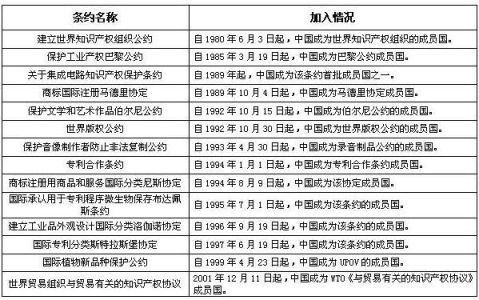
II. China’s Accession to International Conventions for the Protection of IPR and Its Participation in International Negotiation about IPR
8
1. China’s Accession to International Conventions for the Protection of IPR While improving its legal system, China, since the 1980s, has acceded one after the other to the major international conventions and agreements for the protection of IPR. Since 1980 when China first acceded to the Convention Establishing the World Intellectual Property Organization, it has acceded
successively to the Paris Convention for the Protection of Industrial Property, Treaty on Intellectual Property in Respects of Integrated Circuits, Madrid Agreement Concerning the International Registration of Marks, Bern
Convention for the Protection of Literary and Artistic Works, Universal Copyright Convention, Convention for the Protection of Producers of Phonograms against Unauthorized Duplication of their Phonograms, Patent Cooperation Treaty, Nice Agreement Concerning the International Classification of Goods and Service for the Purposes of the Registration of Marks, Budapest Treaty on the International Recognition of the Deposit of Microorganisms for the Purposes of Patent
Procedure, Locarno Agreement Establishing an International Classification for Industrial Design, Strasbourg Agreement Concerning the International Patent Classification, International Convention for the Protection of New Varieties of Plants and WTO’S Agreement on Trade-Related Aspects of IPR (See Table 2 for information about China’s accession to international conventions for the protection of IPR).
During the process of its accession to these international conventions, treaties and agreements, China has always been active in taking part in such activities as prescribed by them, and it has won worldwide recognition for its sincere attitude of adhering to these conventions, treaties and agreements as well as its ability to undertake these international responsibilities.
Furthermore, China is also considering acceding to other international
treaties. An example is that it has set about to draft and amend relevant laws in order to accede to the WIPO Copyright Treaty (WCT) and the WIPO
Performances and Phonograms Treaty (WPPT).
2. China’s Participation in Reforms on International IPR System and in International Negotiations about IPR Issues
Paying close attention to the development of the situation concerning IPR
worldwide, China has actively organized its relevant departments to participate in reforms on IPR system and international negotiations about IPR issues,
initiated by international organizations such as WTO, WIPO, UPOV, APEC, ASEM, etc. For example, China actively took part in the negotiations about such subjects as public health, geographical indications, genetic resources, traditional knowledge and other IPR issues, which were considered to be 9
important parts of the new round Doha negotiation of WTO and which were presided over by TRIPS Council. China organized its relevant departments to attend many conferences held by WIPO, at which Chinese delegation made important speeches on the progress China had made in its IP system as well as on such hot IP issues in the world as international patent system, genetic resources, traditional knowledge, folklore and so on. These speeches fully showed China’s principles and attitude. China also attends conferences organized by UPOV, APEC or ASEM, at which Chinese delegates actively
propaganda the progress Chinese government had made in IP protection, and had beneficial exchange with their counterparts from the rest of the world. Table 2: List of International Conventions on IPR China Acceded to
10
《中国知识产权保护》之三:中国与有关国际组织以及其他国家和地区开展知识产权交流与合作的情况(中英文)
2005-04-05 09:02
为了使大家更好地了解中国知识产权保护方面的有关情况,了解中国政府在知识产权保护方面的决心、立场及做出的巨大努力,我司从20xx年3月24日起分期连续刊登《中国知识产权保护》一文(中英文)。该文共分为六个部分,分别为中国知识产权立法状况、中国参加知识产权保护国际公约与参与知识产权国际谈判的情况、中国与有关国际组织以及其他国家和地区开展知识产权交流与合作的情况、中国开展提高社会保护知识产权意识宣传活动的情况、
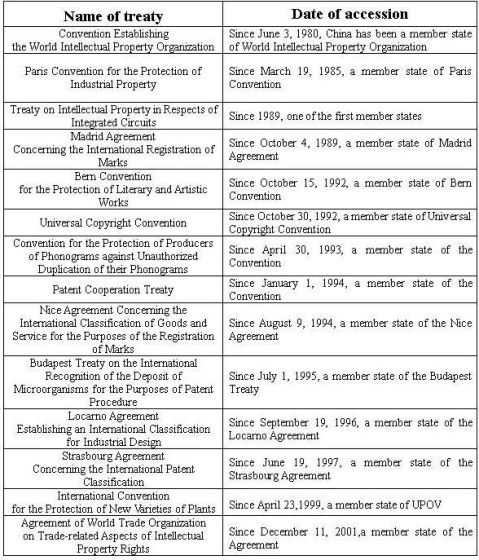
11
中国的知识产权执法状况以及结语等。
我司从今天起,开始刊登该文的第三部分:中国与有关国际组织以及其他国家和地区开展知识产权交流与合作的情况(中英文)。在今后的一段时间里,我司将陆续刊登该文的后面三个部分,敬请关注!
《中国知识产权保护》之三:中国与有关国际组织以及其他国家和地区开展知识产权交流与合
作的情况(中英文)
(一)中国与有关国际组织开展知识产权交流与合作的情况
中国积极采取多种形式加强与世界知识产权组织(WIPO)、国际植物新品种联盟(UPOV)、亚太经合组织(APEC)等有关国际组织在知识产权领域全方位的交流与合作,仅从近几年举办的合作活动中就可窥见一斑。20xx年3月27日至29日,国家版权局与世界知识产权组织(WIPO)在广州联合举办“关于《世界知识产权组织版权条约(WCT)》和《世界知识产权组织表演和录音制品条约(WPPT)》及其对版权产业影响的亚太地区研讨会”;20xx年6月10日至16日,国家知识产权局与世界知识产权组织合作,联合在北京和上海举办知识产权执法高级研讨班,国内外共计250人参会;20xx年7月23日至26日,由国际植物新品种联盟(UPOV)主办,农业部、国家林业局和国家知识产权局协办的“亚洲地区植物新品种保护技术协调会议”在北京举行;20xx年5月21日至25日,国家知识产权局与世界知识产权组织合作,并联合国家工商行政管理总局、国家版权局,在北京举办了中非知识产权论坛、世界知识产权组织政策咨询委员会和世界知识产权组织创造力与发明论坛,会议期间,中国政府与世界知识产权组织签署了《中华人民共和国国家知识产权局与世界知识产权组织合作框架协议》; 20xx年11月20日至28日,国家版权局与世界知识产权组织联合举办了“关于世界知识产权组织版权条约(WCT)和世界知识产权组织表演和录音制品公约(WPPT)中的“向公众传播权巡回研讨会”;20xx年4月,商务部与亚太经合组织在北京成功举办了“APEC第18次知识产权专家组会议”及“专利保护和药品可及性研讨会”等。这些活动对于各国交流经验,加强中国及其他国家的知识产权保护具有重要意义。
(二)中国与其他国家和地区开展知识产权交流与合作的情况
中国与其他国家和地区在知识产权领域也积极开展交流与合作。中美于19xx年签署了《中美知识产权谅解备忘录》,于20xx年建立了知识产权定期磋商机制,在每年开展知识产权定期磋商的基础上, 20xx年共同举办了知识产权圆桌会议,并在20xx年成立了中美商贸联委会保护知识产权工作小组。在与欧盟合作方面,19xx年6月30日,中欧双方签订了有关保护知识产权的会谈纪要; 20xx年10月30日,中欧共同签署了建立“中欧知识产权对话机制”的协议,构筑了中欧双方在知识产权方面进行交流的新平台;20xx年10月21日至22日,中欧双方成功举行了知识产权对话首轮会谈;双方自19xx年进行了为期六年的中国-欧盟知识产权合作项目;另外,在双方部长级中欧经贸混委会项下,也包括了知识产权问题的讨论;中 12
国与法国商标部门之间定期举行中法商标混合工作组会议,19xx年9月24日中国与法国签订了《中华人民共和国政府和法兰西共和国政府关于知识产权的合作协定》。中国与日本、韩国之间也建立了知识产权方面的双边及三边对话与合作机制,自20xx年开始,中日韩三国知识产权局之间每年定期举行政策对话机制;中日著作权行政部门之间每年举行定期会晤,并于20xx年由中国国家版权局与日本文化厅签订了《著作权及邻接权合作协议》;自19xx年起中国工商行政管理总局商标局与日本特许厅之间建立了两局领导不定期会谈机制以及与韩国知识产权局正在磋商建立的密切业务合作关系等;另外,中日、中韩双边经贸联委会、中日韩三国经济局长会议也涉及到知识产权的议题。中国与巴西、墨西哥等国家和地区也开展了卓有成效的知识产权保护方面的交流与合作。
此外,在这些对话与合作框架下,中国与其它国家还多次联合举办有关知识产权问题的研讨会,如20xx年9月4日至6日,国家版权局与中国-欧盟知识产权合作项目办公室在京联合举办版权集体管理研讨会;20xx年8月下旬中国国家版权局与日本文化厅在北京举办了“首届中日著作权研讨会”;20xx年10月23日至24日,在中国-欧盟知识产权合作项目框架下,中国国家知识产权局与欧洲专利局在北京共同举办了“中国与欧洲知识产权保护合作回顾、现状及展望”国际研讨会;20xx年10月中国商务部与欧盟驻华代表团和日本驻华使馆共同举办了“中欧日三国知识产权研讨会”。中国与其他国家和地区通过有效的沟通与对话,增进了解,互通有无,为推进知识产权保护水平的提高做出了共同努力。
III. China’s Exchanges and Cooperation with Relevant International Organizations,
Other Countries and Regions Regarding IPR
1. China’s Exchanges and Cooperation with Relevant International
Organizations Regarding IPR
China has, in an all-round way and by various means, stepped up its exchanges and cooperation in the field of IPR with relevant international organizations such as WIPO, UPOV and APEC. Here are some examples for the last few years. The National Copyright Administration of China (NCAC) cooperated with WIPO to organize "Asia-Pacific Symposium on the Impact of the WCT and WPPT on the Copyright Industry" in Guangzhou from Mar. 27 to 29, 2001. From June 10-16, 2001, State Intellectual Property Office (SIPO) cooperated with WIPO to jointly organize
Intellectual Property Enforcement Training Seminar in Beijing and Shanghai, and over 250 participants were at the seminar. From July 23-26, 2001, Asia Technology Coordination Meeting for Protection of Plant Varieties was held in Beijing, which was sponsored by UPOV and organized by the Ministry of Agriculture, State
Administration for Forestry, and SIPO. From May 21 to 25, 2002, SIPO together with State Administration for Industry and Commerce (SAIC) and NCAC, 13
cooperated with WIPO, sponsored in Beijing the China-Africa Forum on IP, the Forum on Innovative Power and Invention. During the period of the forums, China and WIPO signed the framework agreement of cooperation. From 20 to 28
November, the NCAC and the WIPO jointly held the Symposium on the "Right of Disseminating to Public" mentioned in WCT and WPPT of WIPO. And in April 2004, the Ministry of Commerce and APEC jointly convened in Beijing the APEC 18th Conference of Intellectual Property Experts Group as well as the Symposium on Patent Protection and Access to medicine. These events have not only offered opportunities for countries to exchange experiences and opinions, but also are of great significance for the improvement of intellectual property protection in China as well as the other countries.
2. China’s Exchanges and Cooperation with Other Countries or Regions Regarding IPR
China has also conducted active exchanges and cooperation with other
countries or regions regarding IPR. Let’s take the United States as an example. China and the US signed the Memorandum of Understanding between the
Government of the People’s Republic of China and the Government of the United States of America on the Protection of Intellectual Property in 1992 and established in 2000 a framework for regular consultation mechanism on IP. On the basis of annual consultation, a roundtable discussion on the same issue, jointly sponsored by the two sides, took place in 2003. And in 2004, the Intellectual Property
Protection Working Group of Joint Commission of Commerce and Trade (JCCT) of China and US was set up. Another example is the EU. China and EU signed the Minutes of Discussion on Intellectual Property Protection on Jun. 30, 1992. On Oct. 30, 2003, the two sides signed an agreement on establishing China-EU Dialogue on Intellectual Property which was viewed as a new platform for China and EU to
conduct exchanges regarding IPR, and the first session of dialogue between the two sides was successfully carried out from Oct. 21 to 22, 2004. The EU-China IP
Cooperation Program started in 1996 and lasted for six years. In addition, activities related to the China-EU Mixed Committee on Trade and Economic Cooperation at Minister-Level also include discussions about IP issues. The trademark organs of China and France regularly hold the China-France Trademark Mixed-workgroup Meetings and on Sep. 24, 1998, China and France signed Cooperation Agreement on Intellectual Property between the Government of the People’s Republic of China and the French Government. China has also established bilateral or triangular dialogues and cooperation mechanisms on IP with Japan and South Korea. And since 2001, the Third Trilateral Policy Dialogue Meetings among the Commissioners of the SIPO, the Japan Patent Office (JPO) and the Korea Intellectual Property Office (KIPO) were held annually. The copyright administrations of China and Japan meet regularly, and in 2003, the Chinese National Copyright Administration and Japanese 14
Ministry of Culture signed the Cooperative Agreement on Copyright and
Neighboring Rights. In 1996 the Trademark Bureau of Chinese State Administration for Industry and Commerce and JPO created a mechanism that leaders from both sides should meet irregularly, and currently, the said Chinese organ and South Korean offices are negotiating to foster a close business cooperation relationship between the two sides. Moreover, the joint meetings of bilateral economy and trade between China and Japan as well as between China and South Korea also concern the subject of IPR, so do the Director General Consultation Meeting among China, Japan and South Korea. The Chinese government has also conducted fruitful
exchanges and cooperation on IPR protection with other countries or regions like Brazil, Mexico and so on.
Furthermore, under these frameworks of dialogues and cooperation, China has, in conjunction with other countries, held many seminars over the issue of IPR. For example, from September 4-6, NCAC and European Union Intellectual Property Office (EPO) co-organized the training seminar on the copyright collective
management in Beijing. During the late Aug. 2003, the NCAC and Japanese Ministry of Culture jointly convened the First Sino-Japan Copyright Seminar in Beijing. From 23 to 24 October 2003, under the framework of the EU-China IP Cooperation
Program, the SIPO and the EPO co-organized the Symposium on Partnership in the Protection of Intellectual Property between China and Europe- Past, Present and Future in Beijing. And in Oct. 2004, the Chinese Ministry of Commerce, Delegation of EU in China and Japanese Embassy in China jointly convened the IPR Seminar of China, EU and Japan. Through these effective communications and dialogues, China and other countries or regions have deepened their understanding of each other, benefited from each other’s strengths and jointly contributed to the improvement of the protection of IPR.
《中国知识产权保护》之四:中国开展提高社会保护知识产权意识宣传活动的情况(中英文)
2005-04-08 09:51
为了使大家更好地了解中国知识产权保护方面的有关情况,了解中国政府在知识产权保护方面的决心、立场及做出的巨大努力,我司从20xx年3月24日起分期连续刊登《中国知识产权保护》一文(中英文)。该文共分为六个部分,分别为中国知识产权立法状况、中国参加知识产权保护国际公约与参与知识产权国际谈判的情况、中国与有关国际组织以及其他国家和地区开展知识产权交流与合作的情况、中国开展提高社会保护知识产权意识宣传活动的情况、中国的知识产权执法状况以及结语等。
我司从今天起,开始刊登该文的第四部分:中国开展提高社会保护知识产权意识宣传活动的情况(中英文)。在今后的一段时间里,我司将继续刊登该文的最后两个部分,敬请关注! 15
《中国知识产权保护》之四:中国开展提高社会保护知识产权意识宣传活动的情况(中英文)
中国政府围绕着打击假冒伪劣、侵权盗版,保护知识产权,采取了一系列宣传措施,主要包括:通过新闻采访、电视广播、举办研讨会等方式加强普法宣传,特别是对新的法律法规进行了广泛宣传,同时将知识产权法律教育纳入到全国法制宣传教育工作中;强化舆论监督,通过新闻媒体的宣传报道,对一些量大面广的典型案例进行公开曝光,并连续多年公布破坏市场经济秩序十大案件,起到了震慑犯罪,警示违规的效果。这些宣传活动增强了公众的知识产权保护意识,为全面做好知识产权执法保护工作打下了良好的基础。如20xx年4月,国家知识产权局会同国家工商行政管理总局、国家版权局围绕以“今天创造未来”为主题的第一个世界知识产权日,开展了一系列重大宣传和庆祝活动,在全国掀起了宣传知识产权的新高潮,营造了尊重知识、保护知识产权,共同创造美好未来的社会氛围。
特别值得一提的是,按照20xx年全国整顿和规范市场经济秩序工作部署,为配合4月26日“世界知识产权日”,由全国整规办、全国扫黄打非办、知识产权局、公安部、海关总署、工商总局、质检总局、新闻出版总署、国家版权局等九部委联合组织了“保护知识产权宣传周”活动。该宣传周围绕“尊重知识产权,维护市场秩序”的主题,于20xx年4月19日至4月26日在全国范围内开展。该宣传周旨在普及知识产权保护常识,宣传合理有效保护知识产权的意义,宣传知识产权制度在实施科教兴国和人才强国战略、促进科技创新、文化繁荣、经济发展等方面的重要作用,宣传中国在保护知识产权方面所做的工作和取得的成果,并公布一批侵犯知识产权的典型案例及其查处情况。宣传周包括了以下系列活动:以“中国知识产权保护状况”为主题的中外记者招待会、“中国知识产权与经济发展高级研讨会”、“当代大学生与知识产权主题对话”,第二届“巾帼发明家”评选活动颁奖仪式,在中央电视台播出的“知识产权在中国”专题系列宣传片和知识产权公益广告,在《中国知识产权报》等媒体上开展以“尊重知识产权,维护市场秩序”为主题的征文活动,在中央电视台、《中国新闻出版报》、搜狐网等媒体上开展“著作权”知识竞赛活动,在中央电视台播出由中央电视台及部分地方电视台联合制作的全国百姓发明创造“金智奖”颁奖活动特别节目,在全国各地开展包括小型展览、街头咨询、讲座等宣传活动,在中央电视台播出以“打击侵权盗版,保护知识产权”为主题的晚会等。为保证宣传周活动的顺利举行,中国政府规定由全国整规办、中宣部、国务院新闻办等部门负责组织协调工作,专门成立了"保护知识产权宣传周"活动组委会,在知识产权局设立工作协调组,并向全国各地方有关部门下发了做好宣传周活动筹备工作的通知,要求各地充分认识开展宣传周活动的重要意义,并就宣传周准备、实施和后续阶段的工作提出了具体要求。该次宣传周活动范围广、规模大,取得了良好效果。中国政府希望通过定期的类似活动,集中打击治理侵犯知识产权的行为,提高公众的知识产权保护意识。
IV. Situation about Publicity Activities for Improving the Public Awareness of IPR
Protection in China
16
To crack down on fakes, inferiors and piracies and protect IPR, the Chinese government adopts a series of publicity measures, which mainly include: intensify legal publicity activities ( especially for new laws and regulations) via news coverage, television and broadcastings, and symposiums, and make legal
education concerning intellectual property as part of national legal publicity work simultaneously, strengthen the supervision of public opinion, expose some
influential typical cases through news media and constantly bring to light the top 10 cases damaging market economy for many years, which has produced an awful and preventive effect upon future criminal activities and malpractice. All these have enhanced IP protection awareness of the public and laid a good foundation for comprehensive legal enforcement and protection of IPR. For instance, In April 2001, SIPO cooperated with the SAIC, NCAC to organize series of activities and events for the World Intellectual Property Day entitled "Today Creates the Future". All across the country, there were activities for the dissemination of intellectual property to create an environment for the respect of the knowledge and protection of the IPR for a common beautiful future.
In particular, the National Office of Rectification and Standardization of Market Economic Order, National Anti-Pornography and Anti-Illegal Publications Office, SIPO, Ministry of Public Security, Customs General Administration, SAIC, General Administration for Quality Supervision, Inspection and Quarantine, General Administration for News and Publications, and NCAC, in accordance with the national work plan 2004 for the rectification and standardization of market economic order, organized a joint event named Publicity Week of Intellectual
Property Protection to match the World Intellectual Property Day on April 26. The Publicity Week, with the theme of Respecting Intellectual Property and Maintaining Market Order, was carried out nationwide from Apr.19 to 26, 2004. The said Week aimed to popularize general knowledge about IP protection, publicize the
significance of reasonable and efficient IP protection, the vital role intellectual property system can play in the implementation of the strategy of making the country prosperous by means of science, education and talents and in the promotion of scientific and technological innovation, cultural prosperity and economic development, and publicize China’s work and results concerning IPR protection. In addition, a batch of typical cases infringing on IPR and their
punishments were disclosed during the Week. The Week included the following activities: news conference for the Protection Status regarding China’s IPR attended by both Chinese and foreign reporters, Symposium on China’s IPR and Economic Development, Dialogue about IPR Topic by University Students, Award-given Ceremony for the Second Female Inventors Competition, a series of publicity
programs with the theme of IPR in China and commonwealth advertisements in this 17
regard were provided by China Central Television, the articles-soliciting activity with the subject of Respecting IPR and Maintaining Market Order on such media as China IPR Newspaper, Copyright Knowledge Competition on media such as CCTV, China News and Publication Newspaper and Sohu Website, broadcast of a special award-given program of Golden Wisdom Prize for invention and creation among common people nationwide jointly made by CCTV and some local TV stations and shown on CCTV, publicity activities such as small exhibitions, street consultations, and lectures throughout the country, broadcast of a soiree with the theme of Crack Down on Piracies and Protect IPR on CCTV. To guarantee the smooth
implementation of the said Week, the National Rectification and Standardization Office, Department of Publicity of the Central Committee of the Chinese Communist Party, and Information Office of the State Council were authorized by the Chinese government to be responsible for the organization and coordination of the activity. To this end, a special organizing committee for the Publicity Week of Intellectual Property Protection was formed and a work-coordinating group set up at State
Intellectual Property Office, and a notice about preparations for the Week was
issued to the local departments concerned nationwide. The notice required all the provinces, municipalities and regions to fully realize the significance of the Week, and made clear the specific requirements for its preparations, implementation and follow-up activities. On account of the wide range and large scale, the Week
achieved its desired result. The Chinese government hopes to crack down
infringements on IPR and increase public awareness of protection in this regard through such regular activities.
《中国知识产权保护》之五:中国的知识产权执法状况(中英文)
2005-04-12 10:47
为了使大家更好地了解中国知识产权保护方面的有关情况,了解中国政府在知识产权保护方面的决心、立场及做出的巨大努力,我司从20xx年3月24日起分期连续刊登《中国知识产权保护》一文(中英文)。该文共分为六个部分,分别为中国知识产权立法状况、中国参加知识产权保护国际公约与参与知识产权国际谈判的情况、中国与有关国际组织以及其他国家和地区开展知识产权交流与合作的情况、中国开展提高社会保护知识产权意识宣传活动的情况、中国的知识产权执法状况以及结语等。
我司从今天起,开始刊登该文的第五部分:中国的知识产权执法状况(中英文)。在今后的一段时间里,我司将刊登该文的最后一个部分,敬请关注!
五、中国的知识产权执法状况
(一)中国的知识产权执法渠道
中国的知识产权执法保护有行政和司法两个平行的渠道。权利人在被侵权时可以向法院起诉,也可以向知识产权主管机关申诉。
18
用行政手段保护知识产权是中国知识产权执法的一个重要特色。根据专利法的规定,国务院有关主管部门或地方人民政府可以设立专利管理机关;为有效实施著作权法,中国政府专门成立了国家版权局,各省市、自治区、直辖市和较大的城市也建立了版权行政管理部门;根据商标法的规定,商标管理实行中央统一注册,地方分级管理的原则,从中央到省、市、地、县级的工商行政管理局,都设有商标管理机构;另外,19xx年6月,中国海关总署设立了知识产权边境保护处,全国各海关也指定了本地区内负责知识产权保护的主管部门和联系人。因此,知识产权权利人除通过司法途径外,还可以通过这些行政途径保护其知识产权。对于侵犯知识产权的行为,权利人可以向行政主管机关申诉,行政机关也可以依职权进行查处;知识产权行政主管机关可以在查处过程中对侵权物品进行查封和扣押,可以采取停止侵权的禁令、罚款等救济手段。由于行政程序在打击侵权方面速度较快,费用较低,受到知识产权权利人的欢迎。
在司法方面,中国各级法院已经建立起专门负责审理知识产权案件的审判庭;在诉讼中,法院可以采取财产保全和证据保全的临时措施;对于民事侵权行为,人民法院除可以依法责令侵权人承担停止侵害、消除影响、道歉、赔偿损失等民事责任外,还可以对行为人给予没收非法所得、罚款、拘留等制裁;构成犯罪的,依法追究其刑事责任,中国《刑法》规定,对知识产权犯罪最高可以判处7年有期徒刑。
(二)中国知识产权执法的新成果
近年来,中国政府对知识产权的执法倾注了极大的人力和物力,严厉打击各种假冒伪劣、侵权盗版的行为,取得了引人瞩目的成绩。(见表3、表4、表5)
19xx年至20xx年10月,中国境内已破获非法光盘生产线163条。20xx年8月,在海关总署、新闻出版总署开展的“销毁走私盗版光盘大行动”中,一次就销毁走私盗版光盘4200万张。
值得指出的是,中国各级地方政府已经对知识产权保护对于经济发展的促进作用有了充分认识,基本破除了对本地假冒侵权企业的地方保护主义,积极采取跨地区的行动对假冒侵权行为进行打击。中国环淮海经济区、华东三省一市、东北三省都建立了商标执法网络,这些网络对行政执法行为的跨地区协调和配合发挥了一定作用。同时,各执法部门还注意加强相互间的协调配合,如中国知识产权司法、行政部门已建立了相应的联席会议制度,开展了积极有效的合作。
实践证明,通过各机关的执法工作,有效地打击了侵犯知识产权的不法行为,切实保护了知识产权权利人和消费者的合法权益,改善了市场经济环境、维护了公平竞争的市场经济秩序。
(三)最高人民法院、最高人民检察院公布的《关于办理侵犯知识产权刑事案件具体应用法律若干问题的解释》
为进一步加大对知识产权的刑事司法保护力度,有效打击侵犯知识产权犯罪,维护市场经济秩序,不断提高中国知识产权的法律保护水平,根据中国刑法的有关规定,从惩治侵犯知识产权犯罪的实际需要出发,最高人民法院和最高人民检察院于20xx年12月8日公布了《关于办理侵犯知识产权刑事案件具体应用法律若干问题的解释》(以下简称《解释》),该解释已于20xx年12月22日施行。
19
此次公布的解释对侵犯知识产权犯罪具体适用刑事责任的标准做出了详细和明确的规定,降低了知识产权刑事处罚门槛,扩大了知识产权刑事保护的范围,明确了相关专业术语,集中解决了各地办理此类案件在法律适用方面的疑难问题,提高了相关刑法条文的可操作性。
在起草过程中,司法机关广泛征求了国内相关企业、主管部门的意见并就有关问题先后多次、多渠道、采取多种方式听取了中国外商投资企业协会、欧盟委员会、商业软件联盟、中国商业软件联盟、美国电影协会、中国美国商会、美国信息产业机构等行业协会和部门的意见。可以说,《解释》的起草过程是一个广泛征求意见的过程,尤其是对有关国家和跨国企业的意见给予了充分的关注,这是以前起草司法解释从未有过的。
司法解释的出台,是适应发展社会主义市场经济建立完善知识产权法律制度的要求,也是切实履行中国对国际社会的庄重承诺、树立良好国际形象的司法举措。《司法解释》的出台实施将有助于中国知识产权执法和审判水平的提高,有利于加大打击侵犯知识产权犯罪的力度,提高知识产权刑事保护水平。
(四)中国政府实施政府软件正版化
为更好地履行国际承诺,推动中国的软件知识产权保护工作,中国国务院于20xx年发文,要求政府机构和国有企业使用正版软件。20xx年,为了全面贯彻国务院文件精神,国家版权局、原国家计委、财政部和信息产业部联合发文,要求政府机关和国有企业必须使用正版软件,并建立定期检查制度。中国政府已在中央国务院系统进行了清理和检查,并于20xx年5月前完成了使用软件正版化工作。目前中国政府正在重点推进地方各级政府严格执行国务院有关规定,并取得了重要进展。
(五)国家保护知识产权工作小组、与外商投资企业定期沟通协调机制以及保护知识产权专项行动
1、国家保护知识产权工作小组
20xx年8月,为加强知识产权保护方面的组织领导,国务院调整充实了国家保护知识产权工作小组,国务院副总理吴仪同志任组长,国务院法制办、公安部、商务部、工商总局、新闻出版署(版权局)、海关总署、知识产权局等12个部门为成员单位,负责统筹协调全国知识产权保护工作,督办重大案件。
自20xx年全国整顿和规范市场经济秩序领导小组办公室成立以来,多次开展集中整治侵权盗版等危害市场经济秩序的行动。20xx年,在领导小组的协调指挥下,工商、质检、卫生、农业、药监等行政执法部门共出动执法人员890多万人次,取缔制售假冒伪劣商品窝点50多万个,立案查处120多万起,案值164亿多元。
2、与外商投资企业定期沟通协调机制
为了进一步改善外商投资环境,加大打击侵权和假冒伪劣商品的工作力度,保护知识产权,中国政府于20xx年建立了“政府部门与外商投资企业定期沟通协调机制”。该机制由全国整顿和规范市场经济秩序领导小组办公室牵头,公安部、商务部、海关总署、工商总局、质检总局、新闻出版总署、食品药品监管局、知识产权局、最高人民法院、最高人民检察院和中国外商投资企业协会组成,主要负责定期与外商投资企业互相沟通情况,了解他们在打击假冒商品,保护知识产权,改善外商投资环境,维护统一开放、公平有序的市场秩序等方面反映的问题、提出的意见和建议,并协调组织有关部门进行研究。通过这一机制,各执法部门与外商投资企业加强了打击侵权方面的合作,取得了明显的成效。 20
3、保护知识产权专项行动
为争取我国保护知识产权工作取得更明显成效,国务院决定,从20xx年9月至20xx年8月,由国家知识产权工作组牵头在全国范围内组织开展保护知识产权专项行动,对重点领域、重点环节、重点地区的知识产权保护进行专项整治。这充分显示了中国知识产权保护的立场和决心。今年8月19日和8月27日,国务院先后召开了国家保护知识产权工作组会议和全国保护知识产权专项行动电视电话会议,吴仪副总理到会并作讲话,对保护知识产权专项行动做出了指示和部署。
这次保护知识产权专项行动,按照“全国统一领导,地方政府负责,部门指导协调,各方联合行动”的工作格局,由国家保护知识产权工作组组织领导,各地区、各部门具体实施。专项行动中,将突出重点领域、重点环节和重点地区,以点带面,全面推动。所谓重点领域,就是商标权、著作权、专利权的保护;重点环节就是货物进出口、各类展会和商品批发市场、定牌加工、印刷复制等等;重点地区是指制假售假相对集中的地区。行动中,以知识产权权利人反映强烈、情节严重、影响恶劣的重大侵权案件作为突破口,积极行动,狠狠打击侵犯知识产权的违法犯罪分子。此次专项行动,将把盗版光盘和商标侵权作为重中之重进行打击,特别是把繁华商业区、涉外宾馆饭店、交通中心等作为重点,继续严厉查处非法光盘生产线,扫除贩卖盗版光盘的游商小贩;继续做好各级政府使用正版软件的督查工作,使督查工作制度化,经常化,及时纠正出现的问题;重点规范北京、上海、天津和东南沿海地区以及各地较大的商品交易市场,严厉打击商标侵权行为。国家保护知识产权工作组确定北京、上海、天津、河北、内蒙古、辽宁、江苏、浙江、安徽、福建、山东、河南、湖南、广东、陕西等15个省、自治区、直辖市为此次专项行动的重点地区,专门研究部署,采取有力措施,进行重点整治,并严防反弹。为保证专项行动的顺利进行,各有关部门各司其职,协同配合,强化地方政府责任,形成统一、高效、协调的保护知识产权执法协作机制,开展区域联合执法,切实加强知识产权保护,查处知识产权侵权案件,防止地方保护。为了保证此次专项行动的切实有效,国家保护知识产权工作组和相关部门还组织了六个督导组,分别奔赴各有关区域,重点监督指导专项行动的实施情况。
附件:
表3:20xx年全国各知识产权执法机关执法数据统计表
21
表4:20xx年全国各知识产权执法机关执法数据统计表
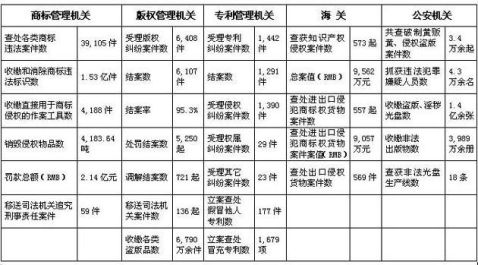
表5:20xx年全国各知识产权执法机关执法数据统计表

22
V. Status Regarding China’s Enforcement of IPR
1. Enforcement Channels of IPR in China
There are two parallel approaches adopted in the enforcement of IPR protection in China, namely, administrative and judicial measures. In case of the infringement, the right holder may either file a lawsuit or apply to competent authorities for administrative measures.
Protecting IPR through administrative means is an important feature of the
enforcement of IPR protection in China. According to the Patent Law, the relevant authorities under the State Council or local governments can establish a patent
administration organ. To effectively implement the Copyright Law, the National Copyright Administration is set up at China’s central level and local administrations in this regard can also be found in various provinces, municipalities and autonomous regions, and even in relatively big cities. Pursuant to the provisions of the Trademark Law, trademark is managed with the principles of registration at central level and administration by local organs. Trademark management organs are included in the administrations for industry and commerce at various levels from state, province, city (prefecture) to county. In
addition, China General Administration of Customs set up a Border Protection Division for IP protection in June 1995 and all the local customs administrations also designated the teams and contact persons responsible for IPR protection within their own areas.
Therefore, the right holder can protect his or her rights through the above administrative

23
approaches in addition to judiciary means. As for acts infringing IPR, the right holder can complain to the competent administrative authorities and the above authorities can also investigate and handle cases in light of their duties. During this process, they can seal up, sequester infringed goods and take such remedies as order of stopping infringement and fines. On account of its rapid crackdown on infringement and low cost, administrative measures are very popular with right holders.
As far as the judiciary aspect is concerned, special judicial tribunals for IP cases have been established at courts at all levels in China. During the process of litigation, a court can take such temporary measures as preservation of evidence or property. In case of torts, the people’s court, in accordance with the law, can not only order a tort-feasor to
undertake such civil liabilities as infringement cessation, negative influence elimination, apology, and loss compensation, but also give him or her such punishments as illegal income confiscation, fines, and detention. In the event of an intellectual property crime, an intellectual property wrongdoer will be given a penal punishment in accordance with the law. As prescribed by the Criminal Law of the People’s Republic of China, a criminal in this regard can be sentenced to a seven–year imprisonment as maximum penalty.
2. New Achievements Regarding IPR Enforcement in China
In recent years, the Chinese government has devoted huge manpower and material resources to IPR enforcement in severely cracking down on counterfeiting and pirating, and attained remarkable results. (See Tables 3, 4 and 5)
From 1996 to Oct. 2003, China seized 163 illegal CD production lines. In Aug. 2003, 42 million smuggled and pirated CDs were destroyed once during the Campaign for the
Destruction of Smuggled and Pirate CDs carried out by the Customs General Administration and the State Administration for News and Publications.
It is worth noting that the Chinese governments at all levels have fully realized the promoting role which IPR protection can play in China’s economic development, basically removed protectionism for their local enterprises involved in counterfeit and infringement, and positively taken cross-region actions to crack down on counterfeiting and pirating. Enforcement networks of trademark have been established in Circular Huaihai Economic Zone in China, one city and three provinces of East China, and three provinces of Northeast China. These networks play a certain role in the cross-region coordination and cooperation of administrative enforcement. In the meantime, relevant enforcement authorities also pay attention to strengthen their mutual coordination and cooperation. For example, a corresponding joint conference system has been instituted between China’s judiciary and administrative organs of intellectual property, and a positive, efficient cooperation has been obtained.
Practice proves that illegal acts infringing IPR have been successfully abated, the lawful 24
rights and interests of right holders and consumers have been protected, the market economy environment improved, and the market economic order of fair competition maintained via the enforcement of various authorities.
3. Interpretations by the Supreme People’s Court and the Supreme People’s Procuratorate on Several Issues of Concrete Application of Laws in Handling Criminal Cases of Infringing Intellectual Property
In accordance with the pertinent provisions of the Criminal Law of the People’s Republic of China, the Supreme People’s Court and the Supreme People’s Procuratorate, out of practical need for punishing IPR infringement crime, promulgated the Interpretations on Several Issues of Concrete Application of Laws in Handling Criminal Cases of Infringing Intellectual Property (hereinafter referred to as Interpretations) on Dec. 8, 2004 to further strengthen criminal judicature protection of intellectual property, effectively crack down on intellectual property infringement crime, maintain market economic order, and constantly improve legal protection level of intellectual property in China. The Interpretations went into effect on Dec. 22, 2004.
The Interpretations give detailed and definite stipulations regarding the standard for concrete application of criminal responsibility for intellectual property crimes, lower the threshold of penal punishment for intellectual property, expand the range of penal protection in intellectual property, determine terminologies concerned, thus resolve
difficult issues of law application by local enforcement, and enhance the maneuverability of relevant articles in the Criminal Law.
During the process of drafting, the judiciary organs extensively solicited opinions of pertinent domestic businesses and authorities in charge and listened to those of industry associations and departments such as the China Association of Enterprises with Foreign Investment, EU Commission, Commercial Software Union, China Commercial Software Union, U.S. Film Association, China American Chamber of Commerce, and U.S. Information Industry Organization through many channels and means for many times. In a word, the drafting of the Interpretations was a process during which views were widely sought. In particular, sufficient attention was given to the opinions of the relevant countries and multinationals, which had never occurred previously in such drafting process.
As a judiciary measure, the promulgation of the Interpretations is to meet the demand to develop socialist market economy and improve the legal system of intellectual property, and to practically keep China’s serious commitments to the international community and set a good international image. It will be beneficial to the enhancement of domestic enforcement level of intellectual property and that of trial in this regard, to the
intensification of crackdown on IPR infringement crimes, and to the improvement of the penal protection of intellectual property.
25
4. Use of Legitimate Software in Government by Chinese Government
To better fulfill its international commitments and promote the IPR protection for software in China, the State Council issued a document in 2000, requiring governmental organs and state-owned enterprises to use legitimate software .To comprehensively carry out the order of the State Council, the NCAC, former State Planning Committee, Ministry of Finance, and Ministry of Information Industry issued a joint document in 2001, requiring governmental organs and state-owned enterprises to use legitimate software and establish a regular inspection system. To this end, the Chinese Government has conducted a check among various ministries and departments of the State Council. It had completed the work for using legitimate software before May 2002. At present, the Government is
concentrating on promoting governments at local levels to strictly implement relevant provisions of the State Council and has made a significant progress in this aspect.
5. National Working Group on IP Protection, the Mechanism of Regular Communication and Coordination with Foreign Investment Enterprises and Nationwide Special Campaign for IPR Protection
1). National Working Group on IP Protection
To strengthen the organization and leadership of IPR protection, the State Council adjusted and reinforced the National Working Group on IP Protection in August 2004. Vice Premier Wu Yi of the State Council has been appointed as head of the Group, and the 12 authorities comprising the group include the Office of Legislative Affairs of the State
Council, the Ministry of Public Security, the Ministry of Commerce, the State Administration for Industry and Commerce, the National Copyright Administration, the State Food and Drug Administration, the General Customs Administration, the Ministry of Information Industry, the State Intellectual Property Office, the General Administration of Quality Supervision, Inspection and Quarantine, the Supreme People’s Court and the Supreme People’s Procuratorate. It is responsible for the unified planning and coordination of national intellectual property protection, and supervision of handling important cases.
Since 2001 when it was set up, the National Office of Rectification and Standardization of Market Economic Order has launched many concentrated campaigns to punish acts of harming market economic order such as infringement and piracy. For instance in 2001, the administrative enforcement authorities such as those for industry and commerce, quality supervision, inspection and quarantine, health, agriculture, and drug administration, under the direction and coordination of the Office, sent enforcement personnel 8.9-million persons/times in total, destroyed over 500,000 dens for counterfeiting and inferior
products, investigated and handled more than 1.2 million cases with their value amounting to 16.4 billion RMB.
2). the Mechanism of Regular Communication and Coordination with Foreign Invested Enterprises
In 2003, the Chinese Government constituted the Mechanism of Regular
26
Communication and Coordination with Foreign Invested Enterprises to further improve the foreign investment environment, reinforce crackdown on infringement, fakes and inferior products, and protect intellectual property. With the National Office for Rectification and Standardization of Market Economic Order taking the lead, the mechanism includes the Ministry of Public Security, Ministry of Commerce, Customs General Administration, State Administration for Industry and Commerce, General Administration for Quality Inspection, State Administration for News and Publications, Supervision Bureau for Food and Medicine, State Intellectual Property Office, Supreme People’s Court, Supreme People’s
Procuratorate, and China Association of Enterprises with Foreign Investment. It is mainly responsible for regular communication with foreign investment enterprises and for getting information about problems and suggestions in terms of cracking down on the counterfeit goods, IPR protection, improving foreign investment environment, and maintaining a unified, open, fair, competitive and orderly market, and organizing and coordinating departments concerned to study them. Through the mechanism, the enforcement
authorities intensify their cooperation in infringement crackdown with foreign investment enterprises and have attained remarkable results.
3). Nationwide Special Campaign for IPR Protection
In order to achieve more concrete results, the State Council decides to launch a nationwide special campaign led by the working group from September 2004 to August 2005. The campaign will focus on the key subjects, key links and key regions. This
campaign fully reveals China’s position and determination to protect intellectual property. On Aug. 19 and 27, 2004, the State Council successively convened a conference of the Working Group for IP Protection and a video and telecommunication conference for
nationwide special campaign for IPR protection, at which Vice Premier Wu Yi gave a speech, making directive and arrangements for the campaign.
Led by the Working Group on Intellectual Property Protection, this campaign will be implemented by local governments and departments under the working pattern featuring uniform leadership by central government, responsibility held by local governments, guidance and coordination by relevant departments, and joint action by all parties
involved. During the campaign, key areas, linkages and regions will be priority so as to promote protection work in all fields and regions. The so-called “key areas” refer to the protection of trademark right, copyright and patent. The “key linkages” refer to the import and export, exhibitions, wholesale markets, OEM, printing and duplication business, etc. The “key regions” refer to the regions where the counterfeiting and piracy are rampant. Besides, the major counterfeiting and piracy cases with serious consequences will be smashed in a forceful manner. The campaign gives its top priority to pirate CDs and trademark infringements. Especially focusing on prosperous business districts,
foreign-visitor-oriented hotels, and traffic centers, the campaign continues to severely crack down on illegal CD production lines and peddlers selling pirated CDs, to supervise governments at all levels in using legitimate software so that supervision can be conducted 27
on an institutionalized and regular basis and problems will be rectified in time, to especially regulate large commodity markets in Beijing, Shanghai, Tianjin, coastal areas of Southeast China, and the rest of the country with a view to severely striking trademark infringements. The working group listed 15 regions as the key areas in the campaign, including Beijing, Shanghai, Tianjin, Hebei, Inner Mongolia, Liaoning, Jiangsu, Zhejiang, Anhui, Fujian,
Henan, Hunan, Guangdong, Shanxi and etc. Local authorities carried out forceful measures to ensure the effectiveness of the actions and to prevent the infringements from
reappearing. All the administrative bodies as well as local governments assumed more specific responsibilities, and formed a unified cooperation mechanism for IPR protection. Moreover, cross-regional enforcement was implemented to strengthen the protection and fight against local protectionism.
To guarantee the success of the special campaign, the Working Group on IP Protection and the relevant departments have organized six supervision groups to especially oversee and direct the implementation of the above operation in regions concerned.
Table 3: the Enforcement Statistics of Relevant IPR Enforcement Organs of China in 2001 28
Table 4: the Enforcement Statistics of Relevant IPR Enforcement Organs of China in 2002
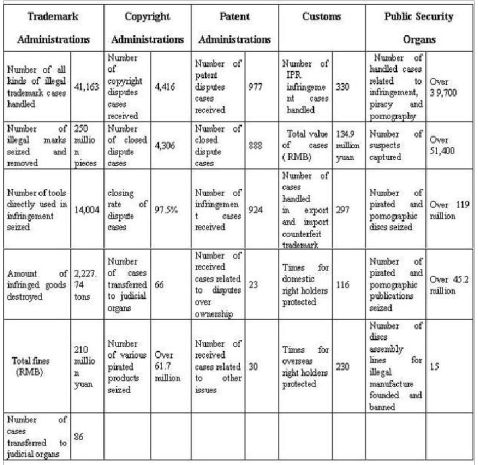
29
Table 5: the Enforcement Statistics of Relevant IPR Enforcement Organs of China in 2003
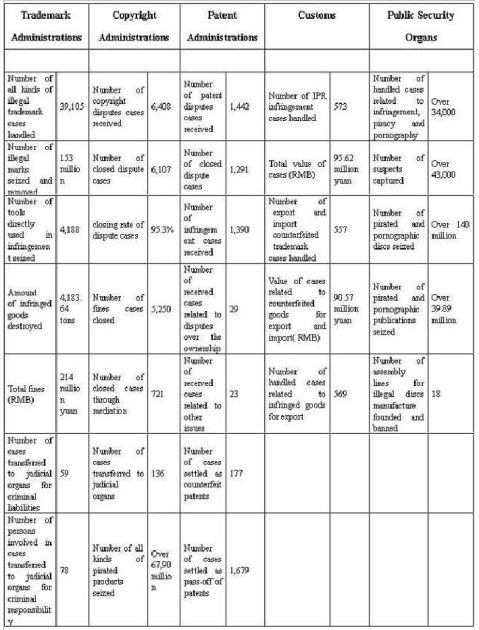
30
《中国知识产权保护》之六:结语(中英文)
2005-04-18 16:27
为了使大家更好地了解中国知识产权保护方面的有关情况,了解中国政府在知识产权保护方面的决心、立场及做出的巨大努力,我司从20xx年3月24日起分期连续刊登了《中国知识产权保护》一文(中英文)。该文共分为六个部分,分别为中国知识产权立法状况、中国参加知识产权保护国际公约与参与知识产权国际谈判的情况、中国与有关国际组织以及其他国家和地区开展知识产权交流与合作的情况、中国开展提高社会保护知识产权意识宣传活动的情况、中国的知识产权执法状况以及结语等。
我司从今天起,开始刊登该文的最后一个部分:结语(中英文)。感谢大家对该文以及我国知识产权保护工作的关注!
《中国知识产权保护》之六:结语
中国政府一直高度重视知识产权保护,不但重视对国外知识产权的保护,同样重视对我们
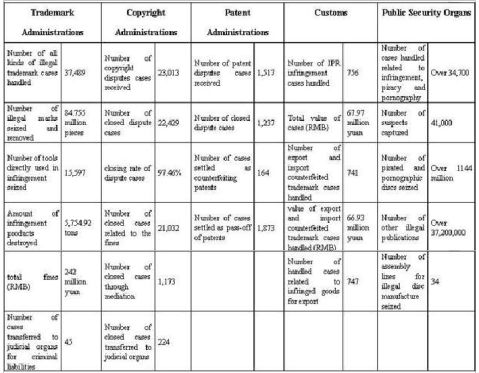
31
自己知识产权的保护。全国上下已经认识到保护知识产权不仅是中国履行入世承诺的要求,也是扩大对外开放,改善投资环境,引进国外投资和先进技术的需要,同时更是加快自身经济建设和社会发展的内在需求。
值得指出的是,任何国家知识产权制度的建立完善,知识产权保护意识的提高,都是一个逐步发展的过程。一个国家的知识产权保护水平,与其经济发展和技术进步的水平是分不开的。目前中国在知识产权保护方面还存在着一些问题,但这些问题正在受到重视并不断得到解决。中国政府对保护知识产权的决心和态度是一贯的,来自各国的知识产权权利人的合法权益都将在中国受到保障,所有侵权和假冒的行为都将被依法处理。而且,知识产权保护是一个世界性的问题,需要各方通力合作。中国政府希望有关国家要消除对中国知识产权保护的疑虑,要更加多地了解中国在知识产权保护方面的法律、法规和执法情况,采取合作的方式,共同促进技术的传播与进步。
VI. Conclusive Remarks
The Chinese government has always attached great importance to IPR
protection, not only to the protection of foreign Intellectual Property, but also to that of our own Intellectual Property. So far, the whole nation has realized that the IPR protection is not only the requirement to keep China’s commitments to the World Trade Organization, but also the necessity to broaden its opening to the outside world, improve investment environment, and introduce overseas
investment and advanced technologies. In the meantime, the IPR protection is also an intrinsic need to speed up our own economic construction and social
development.
Anyhow, it is worth pointing out that the establishment and perfection of IPR system and the increased protection awareness of IPR for any country are bound to be a process of gradual development. The protection level of IPR in one country closely links with that of its economic development and technological progress. At present, some problems still exist in China’s IPR protection, but they have attracted our special attention and are continually resolved one after another. The Chinese government’s determination and attitude regarding IPR protection have been
consistent, the legal rights and interests of right holders from the rest of the world will be protected in China and all infringement and counterfeiting acts will be
punished in accordance with the laws. Furthermore, IPR protection is a worldwide issue, demanding full cooperation from all sides. The Chinese government hopes that some countries should remove their suspicions about China’s IPR protection, have a better understanding of Chinese laws, regulations, and enforcement regarding IPR protection, and with cooperative attitude to jointly promote technological progress.
32
33
